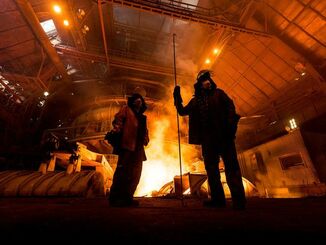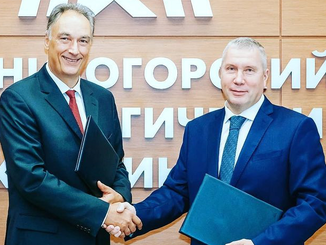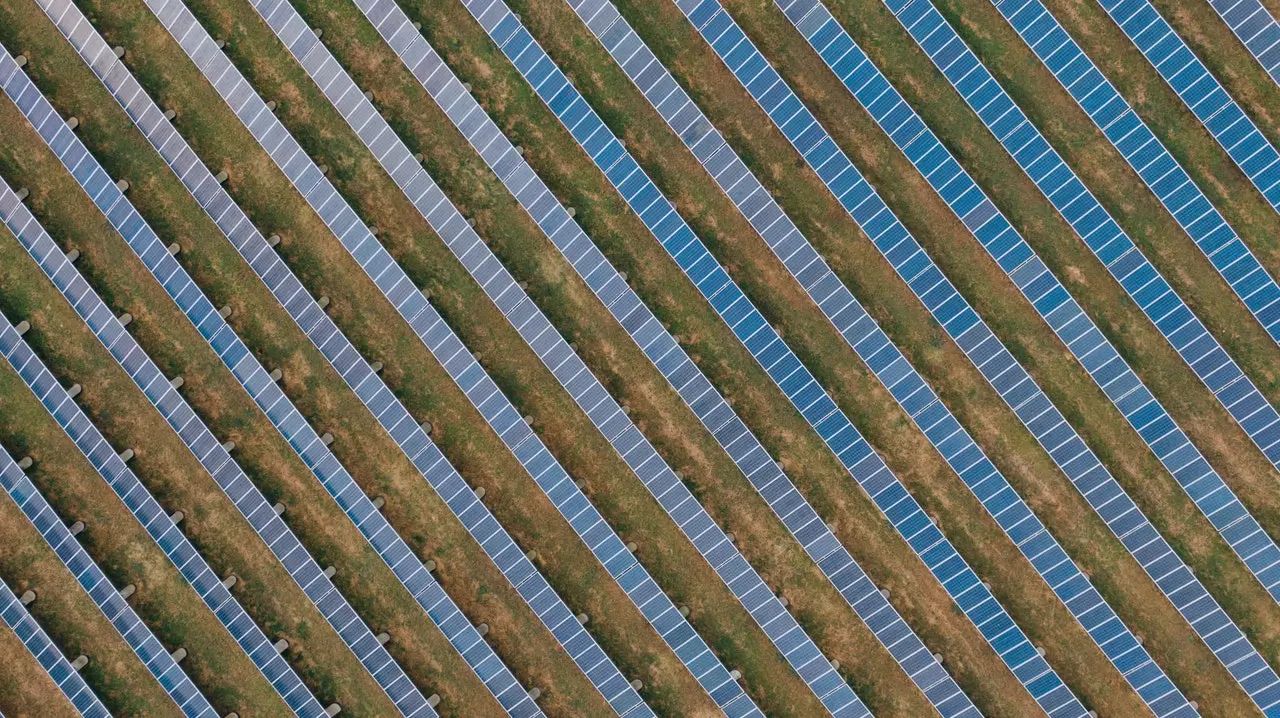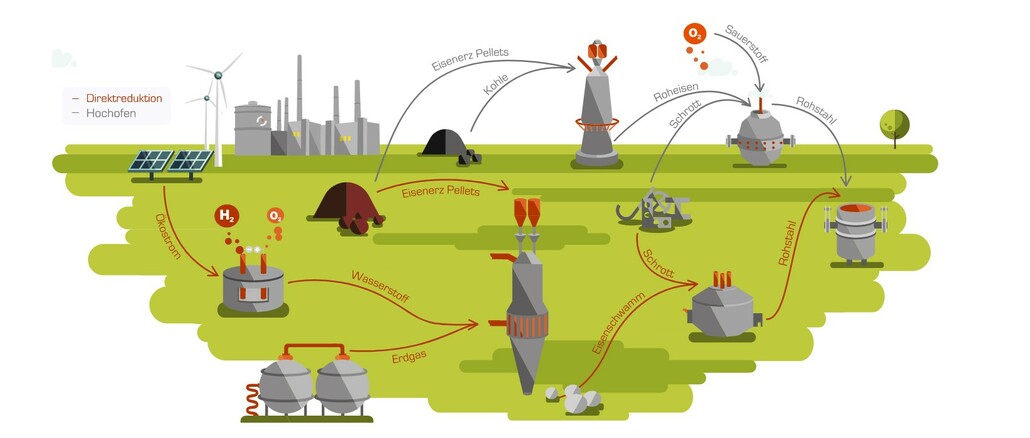
Anyone who would have claimed 7 or 8 years ago that coal, or more specifically carbon, would become almost irrelevant in steel production around 2050 would have been a shoo-in for several years’ logging in a county hospital. Today, all major steel producers are working on decarbonising production. Example Salzgitter AG
At the latest since China announced its intention to become climate-neutral by 2060, the cost argument for conventional steel production has become less important. As much as the steel lobby ran up a storm against new production processes until recently, it is now running into the void.
The propaganda part of the announcement from the “Middle Kingdom” may not be insignificant and above all not unwelcome, but it was probably meant seriously: China consists to a large extent of desert, and the deserts are expanding as a result of the climate catastrophe. In addition, the glaciers of the Himalayas are melting far too rapidly on its northern side as well, and this meltwater is flowing through China.
Long before the signal from the People’s Republic, Salzgitter AG was already thinking about the substitution of carbon in steel production and launched the SALCOS project in 2015. SALCOS stands for “SAlzgitterLowCO2 Steelmaking”.
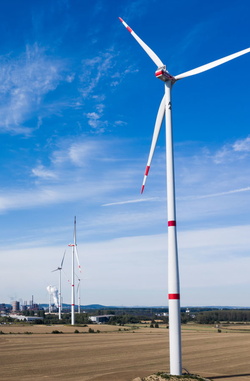
Wind power for steel production?
The aim of the project is to achieve the lowest possibleCO2 emissions in steel production as quickly and efficiently as possible. Efficient means, among other things, saying goodbye to fossil fuels and using renewable energy sources as far as possible. However, steel production should be as uniform as possible, and the only reasonably available source of energy, hydroelectric power, is practically unavailable in the North German Plain due to the lack of head.
However, wind and sun supply far too unevenly to be used directly. To compensate for this fickleness, huge amounts of energy would have to be stored. There are many ways to do this, physical and chemical, efficient and inefficient.
Storage options include the generation of hydrogen by electrolysis. This has a mistaken reputation for being inefficient. This is because there is often little expertise behind published opinion. Efficiencies of 80 to over 90 percent, measured in terms of the upper calorific value of the energy supplied, and of 40 to 65 percent in the electrolysis itself are not bad at all.
The fact that Salzgitter wants to turn wind into electricity and electricity into hydrogen has nothing to do with energy storage, however, but with chemical reactions. More on that in a moment.
Strict schedule
A strict timetable has been set to achieve aCO2 reduction of at least 95 percent by 2050 – certainly in the hope of reaching the target even faster:
| 2015 | Project start SALCOS |
| 2016 | Project start GrInHy (Green Industrial Hydrogen) |
| 2017 | Launch of the SALCOS Feasibility Study (MACOR) |
| 2019 | Start GrInHy 2.0 |
| 2020 | Start of SALCOS accompanying research BeWiSe = MACOR follow-up) |
| 2020 | Commissioning of the Salzgitter wind farm |
| 2020 | Commissioning of the world’s largest high-temperature electrolysis plant(GrInHy 2.0) |
| 2021 | Commissioning “WindH2” electrolysis |
| 2022 | Commissioning of the first direct reduction plant thatcan be operated flexibly with H2 or natural gas (predominantly CH4) |
| 2026 | First SALCOS expansion stage:CO2 reduction of 30 percent |
| as of 2030 | Second SALCOS expansion stage:CO2 reduction by 50 percent |
| by 2050 | Complete SALCOS conversion:CO2 reduction of 95 percent |
“Direct reduction” – this is the crucial keyword and explanation for the generation of H2 by wind power. It is not about energy storage in the form of H2 at all; rather, the hydrogen is needed instead of carbon in order to produce pig iron from rust, or, more elegantly, iron ore. Natural gas is still used in a transitional phase; natural gas consists largely of methane (CH4). The pig iron is then in the form of sponge iron which, mixed with scrap, is melted down in an electric arc furnace and thus refined into solid steel.
Instead ofCO2, H2O is produced during the reduction by hydrogen.CO2 that is not produced does not have to be degraded (e.g. by photosynthesis) or stored. The resulting water can be reused in the process.
In the long term, the existing three blast furnaces are to be gradually replaced by a combination of direct reduction plants and electric arc furnaces. This process change could reduceCO2 emissions by over 95 percent by 2050. At least from a technical point of view, this is realistic. Policy support is needed for economic viability. At present, the chances of finding global solutions are relatively good.

The “Wind Hydrogen Salzgitter – WindH2” sector coupling project was commissioned punctually in March of this year in the presence of representatives from industry (Salzgitter, Avacon and Linde) and politics (Federal Ministry of Economics, State of Lower Saxony). The costs amount to about 50 million Euros, the construction of the electrolysis plant was supported by the KfW. The expressed downright euphoria.
This is based on seven wind turbines with a total output of 30 MW. They supply two 1.25 MW PEM electrolysis units, which can produce 450 m³ of high-purity hydrogen per hour. Hydrogen is already used for annealing processes and in hot-dip galvanizing. At present, Linde still supplies most of the hydrogen by truck, and the company will continue to ensure a steady supply in the future.
Flat steel already greener today
Salzgitter AG will soon be offering “green flat steel” in various grades and dimensions. The production of these varieties will generate less than a quarter of CO2 compared to current production. To this end, one of the two continuous casters at the Peine steelworks is being converted for the casting of slabs.
Salzgitter AG was the first European steel manufacturer to receive two conformity statements from TÜV Süd in accordance with the Veristeel procedure (developed on the basis of DIN EN ISO/IEC 17029). TÜV Süd confirms a reduction of more than 75 percent in theCO2 balance of the slab and more than 66 percent in theCO2 balance of the hot-dip galvanized coil.
GrInHy 1.0 – PEM electrolysis
In 2016, Salzgitter AG launched the GrInHy (Green Industrial Hydrogen) project to generate hydrogen through electrolysis.
The core of the plant is a PEM electrolyser (PEM = Proton Exchange Membrane) with a capacity of 400 Nm³/h (Nm³ = standard cubic meter) and 2 MWel installed power.
The electrolyser, which is installed centrally on the plant site, separates water into hydrogen and oxygen when a voltage is applied. Highly pure, distilled water is required for this process, which is treated from service water obtained in the company’s own waterworks. The electricity comes from the plant’s own power grid, which is now indirectly supported by wind energy.
The hydrogen leaves the electrolysis at about 3 Mpa (approx. 30 bar) and is fed into the existing hydrogen network via a buffer storage at 1 MPa. The oxygen produced is not used at first.
GrInHy 2.0 – High temperature electrolysis
In 2020, Salzgitter AG commissioned the largest high-temperature electrolyzer to date, which uses steam from the waste heat of steel production. The hydrogen produced in this way is to replace the “grey” hydrogen obtained from natural gas.
High-temperature electrolysis takes place at 100 to over 800 °C. The higher the temperature, the higher the efficiency. However, the higher the temperature, the greater the effort required to control the process. At 100 °C, efficiencies of over 80 percent (measured at the upper calorific value) are already achieved (electrolyser approx. 40 percent), at 850 °C it is over 90 percent or 65 percent.
Salzgitter does not name any temperatures, but states an efficiency of 84 percent, measured at the lower calorific value. Since the company can use the waste heat from steel production, the plant also works very efficiently with it – without extreme operating conditions.
SALCOS
Under the project name SALCOS, Salzgitter AG and its partners, such as Linde, Avacon and Evonik, are working on the decarbonization of steel production using hydrogen by 2050.
The joint concept was already developed in 2015. It includes hydrogen production and the conversion of steel production step by step from blast furnaces to direct reduction, initially on the basis of natural gas (essentially methane), and later on the basis of hydrogen. This could completely replace the carbon previously required and reduce carbon dioxide emissions by 95 percent. Instead of carbon dioxide, water would be produced.
The result of direct reduction is sponge iron, which would be melted down together with scrap in electric arc furnaces. The first of these plants could come on stream in 2026.
Some voices on SALCOS:
Prof. Dr.-Ing. Heinz Jörg Fuhrmann, Chairman of the Executive Board of Salzgitter AG:
“We are proud to be pioneers of the industrial use of green hydrogen in the steel industry. As demonstrated by our SALCOS project, we are technologically capable of achieving significantCO2 reductions using hydrogen. The ‘Windwasserstoff Salzgitter – WindH2’ sector coupling, which is unique in Germany to date, is a significant building block on the way to climate-friendly steel production.”
State Secretary Andreas Feicht, Federal Ministry for Economic Affairs and Energy:
“The project ‘Windwasserstoff Salzgitter – WindH2’ was supported by the Federal Ministry for Economic Affairs and Energy with 1.1 million euros from the federal funding for energy efficiency in the economy. With the sector coupling of wind energy and hydrogen production, the project implements one of the objectives of the German government’s National Hydrogen Strategy: The use of climate-friendly produced hydrogen from renewable energies is a key element for decarbonisation in industry.”
Dr. Johannes Teyssen, Chairman of the Board of Management of E.on SE:
“Green gases have what it takes to become the ‘staple’ of the energy transition and make a significant contribution to the decarbonisation of industry mobility and heat. The jointly implemented project symbolizes a milestone on the way to virtuallyCO2-free steel production and shows that fossil fuels can be replaced through intelligent sector coupling.”
Dr. Bernd Althusmann, Lower Saxony Minister for Economic Affairs, Labour, Transport and Digital Affairs:
“In view of the climate targets, the decarbonisation of steel production with the help of green hydrogen is a milestone for the German steel industry. I am therefore all the more pleased that Lower Saxony, through Salzgitter AG, is paving the way for this development throughout Germany and is launching a promising project with WindH2. With its pioneering work, Salzgitter is providing the blueprint for future climate-friendly production technologies at Germany’s industrial location, while at the same time securing qualified jobs in Lower Saxony.”
Marten Bunnemann, Chairman of the Executive Board Avacon AG:
“With the wind farm on the industrial premises of Salzgitter AG, we are supplying regenerative electricity for the production of green hydrogen. This is used directly within the production processes and replaces fossil fuels. The entry into the hydrogen economy is taking place in regional stand-alone solutions, such as in Salzgitter, which are increasingly being combined to form an overall system. We will continue to drive this process forward together with our partners in politics, science and industry.”
Olaf Lies, Lower Saxony Minister for the Environment, Energy, Building and Climate Protection:
“What many thought was a wild vision of the future a few years ago is happening here: the gradual decarbonisation of steel production. Climate protection in the energy and industrial sector is much more than just electricity from renewable sources. This is about securing highly qualified jobs and the further development of our industrial location. As the cost of CO rises, green steel will also become increasingly economical. The world is therefore watching with interest to see what is being created here. The pioneering work done here has every chance of developing into an export hit ‘Made in Germany’.”
(Source: Salzgitter AG)

